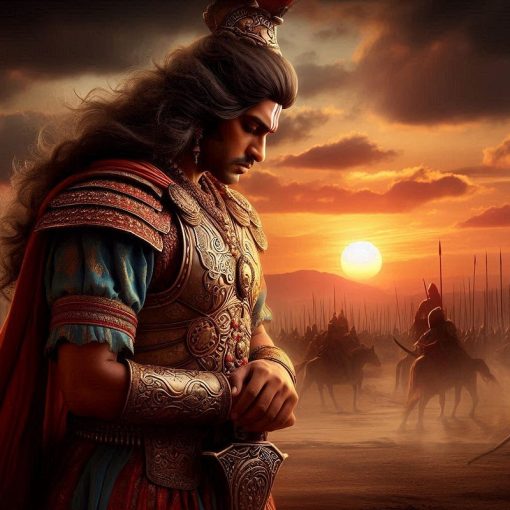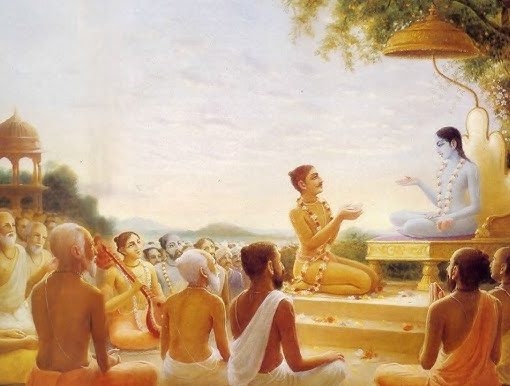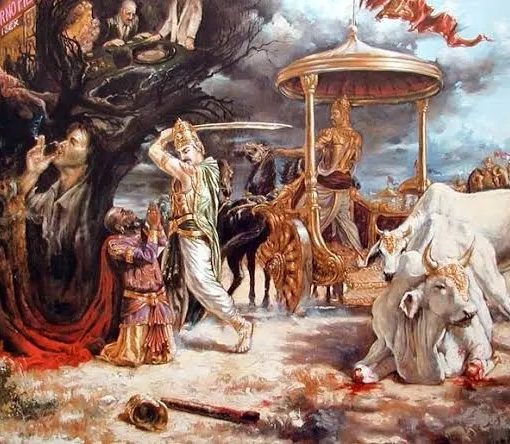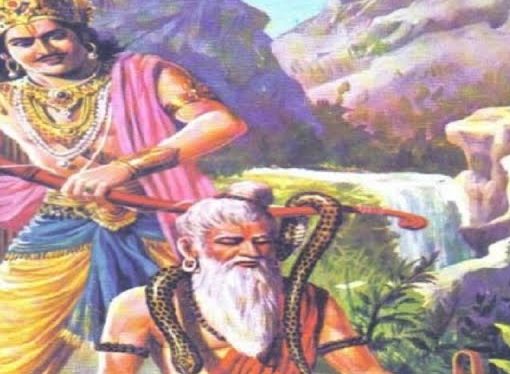In Chapter Eleven of the Śrīmad-Bhāgavatam, we witness the return of Lord Krishna to Dvārakā after His stay in Hastināpura. The citizens of Dvārakā are overwhelmed with love and devotion, preparing to welcome the Supreme Lord back to their city. This chapter paints a picture of the spiritual bliss and excitement experienced by devotees when in the presence of the Lord. As we explore the events and lessons from this chapter, we are invited to deepen our understanding of love, devotion, and service to God.
A Grand Welcome for Krishna
The people of Dvārakā, knowing of Krishna’s return, joyfully prepare for His arrival. Their hearts are filled with anticipation, and their love is so intense that they cannot wait to see Him. They decorate the roads with fragrant flowers, flags, and festoons, creating a festive atmosphere. Men, women, and children, irrespective of age, rush toward the city gates, their eyes eagerly scanning the horizon for Krishna’s chariot.
This scene symbolizes the natural response of the soul when it encounters the Lord—eagerness, joy, and devotion. The Dvārakāvāsīs’ preparations reflect a pure, unalloyed desire to serve Krishna, teaching us that the heart’s truest fulfillment lies in devotion to God. In this material world, we often prepare for various events with great enthusiasm—weddings, birthdays, and festivals. But how often do we prepare with similar enthusiasm for our spiritual practices? This chapter encourages us to cultivate a spirit of anticipation and joy in our daily sādhanā, as Krishna’s presence is the real source of fulfillment.
Krishna’s Affection for His Devotees
When Krishna’s chariot enters Dvārakā, His eyes meet those of His beloved citizens. His gaze is filled with love, mercy, and compassion. The Lord’s affection for His devotees is boundless. He reciprocates their devotion not with mere gifts but with His very presence, which is the highest benediction. This moment is a reminder that Krishna is not an aloof God, but a deeply loving and personal deity who responds to the love of His devotees.
Krishna’s affection is also a call to embrace a personal relationship with Him. Sometimes, we may feel distant from God due to our own limitations, sins, or doubts. But Krishna’s love is unconditional. He is always eager to shower His mercy, irrespective of our past mistakes. As Bhakti practitioners, we can find immense solace in this divine assurance: Krishna does not care for our material qualifications, but for the sincerity of our hearts.
The Beauty of Krishna
As Krishna passes through the streets of Dvārakā, His divine beauty captivates everyone. His lotus-like face, adorned with a peacock feather, radiates a divine charm that enchants the minds and hearts of all who behold Him. The residents’ eyes become fixed on Him, unable to look away, as if they wish to drink the nectar of His beauty forever.
Krishna’s beauty is not just an external attraction; it is deeply spiritual. His form is transcendental and fully spiritual, beyond the modes of material nature. The description of Krishna’s beauty in this chapter reminds us that the Lord’s form is meant to be meditated upon, cherished, and loved. By focusing our mind on Krishna’s beauty, we can overcome the temporary distractions and sufferings of the material world. Just as the residents of Dvārakā found solace in Krishna’s form, we too can find peace by meditating on His divine features through daily spiritual practices.
Lessons on Unity in Devotion
In Dvārakā, everyone comes together, united in their love for Krishna. The entire city, regardless of social status or occupation, participates in the grand reception. This unity in devotion is a powerful lesson for us today. In modern times, society is often divided by religion, caste, class, or nationality. However, devotion to God transcends all material designations. It is the unifying force that brings souls together.
The residents of Dvārakā teach us that when our hearts are centered on God, worldly differences dissolve. As practitioners of bhakti, we should strive to build a community of love, unity, and cooperation centered around Krishna. When we focus on Krishna, differences fade, and genuine spiritual brotherhood emerges.
Krishna and His Family
After entering the city, Krishna meets His family members, the Yadu dynasty. He offers respect to His elders, embraces His brothers, and blesses the children. His interactions reflect the ideal behavior of a devotee toward family members. Krishna’s example emphasizes the importance of respecting elders, being affectionate toward equals, and protecting and nurturing dependents. It is a reminder that spirituality does not mean neglecting family responsibilities. Rather, we are encouraged to perform our duties with love and dedication, seeing them as part of our service to God.
Krishna’s behavior toward His family demonstrates the principle of yukta-vairāgya, or proper renunciation. A devotee does not renounce relationships but sees them in connection with Krishna. In this way, family life becomes a spiritual practice rather than a material entanglement.
The Ecstasy of Devotional Separation
As Krishna enters the palace, the queens of Dvārakā are overwhelmed with joy. For many months, they have been experiencing the pain of separation from Krishna. This feeling of separation, though painful, is not ordinary. In the spiritual realm, it is known as vipralambha, a transcendental emotion that intensifies one’s love for Krishna.
The queens’ ecstatic reunion with Krishna teaches us that separation from God can be a powerful spiritual experience. It deepens our yearning and intensifies our devotion. When we feel distant from Krishna, rather than becoming discouraged, we can use that feeling as an opportunity to strengthen our longing for Him. Just as a dry spell makes the earth more eager for rain, moments of spiritual dryness can make our hearts more eager for God’s grace.
Krishna’s Compassion for All Living Beings
Krishna does not just bless the residents of Dvārakā; His compassion extends to all living beings. The animals, birds, and even the trees of Dvārakā are described as being enlivened by His presence. This is a reminder that God’s mercy is not limited to human beings alone; it encompasses all forms of life.
As devotees, we are called to develop a similar attitude of compassion. True spirituality is not just about personal liberation but about caring for all living entities. By cultivating kindness toward others—be they humans, animals, or even plants—we align ourselves with Krishna’s heart. This compassionate spirit can be practically expressed through acts of kindness, charity, and care for the environment, reflecting Krishna’s boundless love.
The Role of Devotional Association
The entire city of Dvārakā comes alive because of the presence of pure devotees who are eagerly awaiting Krishna. The Bhāgavatam emphasizes the importance of satsanga, or the association of devotees, as a crucial aspect of spiritual life. It is through the company of sincere devotees that we develop a genuine love for Krishna.
Devotee association serves as a mirror, reflecting our shortcomings and encouraging us to improve. Just as the residents of Dvārakā were strengthened by each other’s enthusiasm, we too are strengthened by associating with fellow devotees. As practitioners, we should actively seek the company of those who inspire us to deepen our love for Krishna. Whether through temple visits, spiritual discussions, or community service, staying connected with devotees fuels our own spiritual journey.
The Central Lesson: Make Krishna the Focus of Life
The residents of Dvārakā teach us that Krishna should be the central focus of our lives. Everything they do—be it their household duties, social activities, or governance—is done with Krishna at the center. This principle of Krishna-centeredness is the essence of bhakti.
In our own lives, we may have many responsibilities and distractions, but by keeping Krishna at the center, everything becomes spiritualized. Our work, relationships, and even challenges become opportunities for service. By offering all our activities to Krishna, we gradually transform material life into spiritual life.
Living the Teachings of SB 1.11
The lessons of Śrīmad-Bhāgavatam 1.11 are not just theoretical but meant to be lived. Here are some practical ways to apply these teachings in daily life:
- Cultivate Eagerness for Krishna: Like the residents of Dvārakā, start each day with anticipation and excitement for your spiritual practices. Make chanting, reading, and meditation a joyful routine, seeing them as direct interactions with Krishna.
- Nurture Devotional Relationships: In your community, family, and friendships, try to cultivate relationships that are centered on Krishna. Engage in spiritual discussions, shared prayers, and devotional activities that deepen mutual love for God.
- Practice Compassion: Extend Krishna’s love by serving others—whether through charity, environmental care, or simply kind words. Reflect Krishna’s compassion in your interactions.
- Seek Satsanga: Regularly associate with sincere devotees. Attend classes, join spiritual retreats, and engage in service projects with others who share the same aspiration for Krishna consciousness.
- See God in All Situations: No matter what life brings—joy, sorrow, success, or failure—try to see it as Krishna’s arrangement for your spiritual growth. Even challenges are opportunities for deepening your surrender to Krishna.
Conclusion: The Path to Divine Love
Chapter 1.11 of the Śrīmad-Bhāgavatam reminds us that love for Krishna is the highest goal of life. The people of Dvārakā set a perfect example of this love, showing that it is possible to live a God-centered life, full of joy, unity, and compassion. By following their footsteps, we too can transform our lives into a divine offering.
The journey of bhakti is not always easy, but it is filled with the highest joy and fulfillment. With Krishna as the central focus, everything becomes beautiful and meaningful. Let us all strive to welcome Krishna into our hearts as the residents of Dvārakā did, with eagerness, devotion, and unwavering love.





